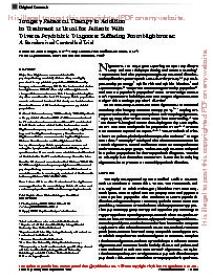Imagery rehearsal therapy in addition to treatment as usual for patients with diverse psychiatric diagnoses suffering from nightmares: A randomized controlled trial
Imagery rehearsal therapy in addition to treatment as usual for patients with diverse psychiatric diagnoses suffering from nightmares: A randomized controlled trial
Geplaatst op 24-09-2015
Objective: Nightmares are associated with psychopathology and daily distress. They are highly prevalent in a psychiatric population (30%). Currently, imagery rehearsal therapy (IRT) is the treatment of choice for nightmares. With IRT, the script of the nightmare is changed into a new dream, which is imagined during the day. However, the effects of IRT in a psychiatric population remain unknown. The aim of this study was to determine the effectiveness of IRT in a heterogeneous psychiatric population.
Method: Between January 2006 and July 2010, 90 patients with psychiatric disorders (DSM-IV-TR) were randomized to IRT or treatment-as-usual conditions. IRT consisted of 6 individual sessions added to the treatment as usual. Nightmare frequency was assessed using daily nightmare logs and the Nightmare Frequency Questionnaire. Nightmare distress was assessed using the Nightmare Distress Questionnaire and the Nightmare Effects Survey. General psychiatric symptoms were assessed using the Symptom Checklist-90 and a PTSD symptom questionnaire. Assessments were administered at the start of the trial, after the IRT and at follow-up 3 months later.
Results: IRT showed a moderate effect (Cohen d = 0.5–0.7, P < .05) on nightmare frequency, nightmare distress, and psychopathology measures compared with treatment as usual. These effects were largely sustained at the 3-month follow-up (Cohen d = 0.4–0.6, P < .10).
Conclusions: IRT is an effective treatment for nightmares among patients with comorbid psychiatric disorders and can be employed in addition to the on-going treatment.
Geachte bezoeker,
De informatie die u nu opvraagt, kan door psychotraumanet niet aan u worden getoond. Dit kan verschillende redenen hebben,
waarvan (bescherming van het) auteursrecht de meeste voorkomende is. Wanneer het mogelijk is om u door te verwijzen naar de bron
van deze informatie, dan ziet u hier onder een link naar die plek.
Als er geen link staat, kunt u contact opnemen met de bibliotheek,
die u verder op weg kan helpen.
Met vriendelijke groet,
Het psychotraumanet-team.
Reference:
A. M. van Schagen, J. Lancee, I. W. de Groot, V. I. Spoormaker, & J. van den Bout, | 2015
In: The journal of clinical psychiatry, ISSN 0160-6689 | 76 | 9 | 1105-1113
http://www.psychiatrist.com/JCP/article/Pages/2015/v76n09/v76n0903.aspx
In: The journal of clinical psychiatry, ISSN 0160-6689 | 76 | 9 | 1105-1113
http://www.psychiatrist.com/JCP/article/Pages/2015/v76n09/v76n0903.aspx


